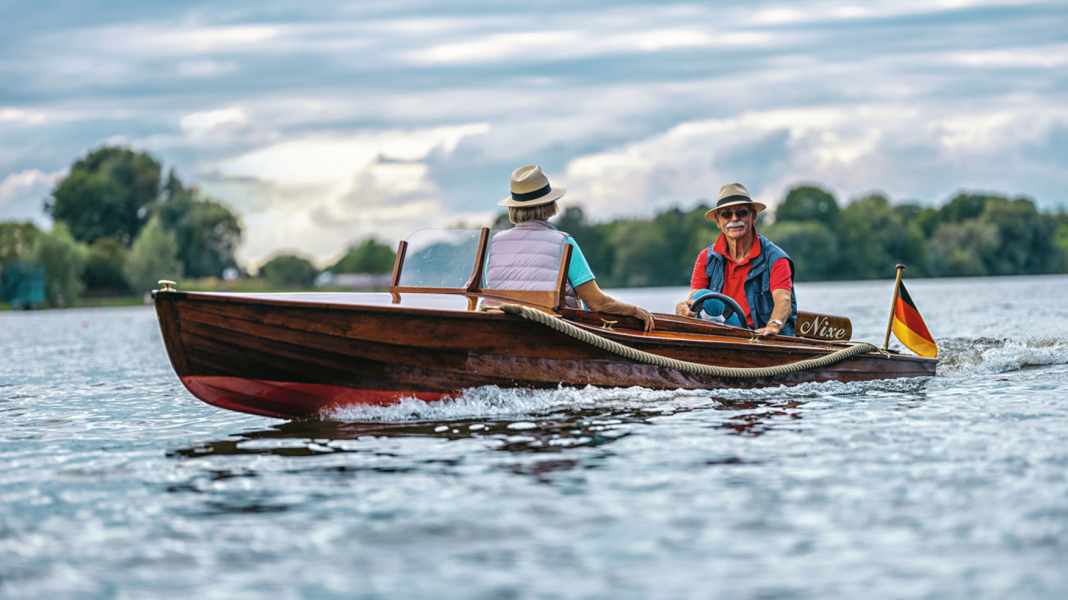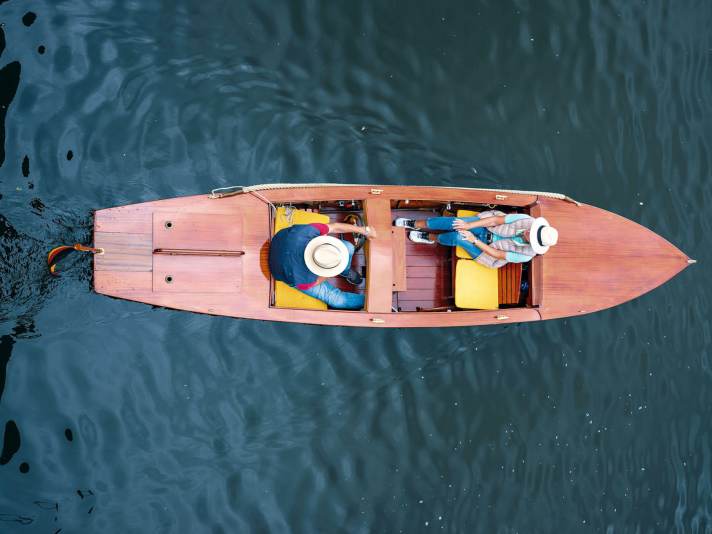
It was advertised in a cheese magazine," recalls Menno Wolters, "at our home near Freiburg." A place where one would certainly not look for such a wooden motorboat. But the 78-year-old immediately liked the Wellenbinder crack, especially the long and narrow shape, the outer skin made of mahogany planks clinkered with copper rivets and the bronze fittings. "You don't see something like this every day," said Wolters, "It would make a nice excursion boat for our summer residence." A houseboat on the Dove-Elbe. It quickly became clear: "I have to take a look at this boat."
Three hours later, across the French border and down to the river Saône, the boat was moored in front of him: elegant and well-maintained, but also very narrow and with very little freeboard. The seller was also from the Freiburg area, owned a holiday home and had used the boat on the Saône for several years. Wolters also learnt a few more key points about the history of the "Nixe" from him, but not many: "She was built somewhere in the GDR in 1950. He couldn't tell me exactly where."

Visually, the boat is one of a series of classic wave-tying boats that were built in series at the VEB shipyards and were all named after fish or birds such as trout, scalar, sea eagle or petrel. Unfortunately, "Nixe" no longer has a nameplate, and she also looks a little different from the boats listed in the archives of the VEB shipyards. "Was this one a one-off?" wonders Wolters. Four decades after it was built, the boat underwent a fairly extensive refit in the early 1990s and was given a new deck. The condition of the boat today is really excellent.
Need more information? The classic report on the Liuzzi Star 6 with many more pictures can be found in BOOTE issue 08/2021 from 14 July 2021 at newsstands or online at Delius Klasing Shop.
The Wellenbinder goes back to the German boat builder Claus Engelbrecht, whose colleague Arthur Tiller later revised and extended the design. Tiller's Wellenbinder is a series of round chandlers with a length to width ratio of between 1 to 5 and 1 to 10. The long and narrow shape is based on the aim of designing a boat that does not create waves. This was to be achieved by the waves generated by the underwater hull overlapping with the waves from the bow and stern and cancelling each other out.
In addition to this special effect, the ingenious hull shape had a second advantage: a relatively high possible speed with a relatively small engine. In the boat documents of his "Nixe", Wolters found two aluminium plaques confirming the boat's participation in the motorboat races in Bad Saarow in 1956 and 1957. "Back then, the boat still had a sideboard engine," Wolters read in the old papers. An engine that was still very popular at the time, especially with the König and Tümmler models in the East.

"There was only one thing that didn't match the image at all when we bought it in France," laughs Wolters, flicking back a few pages in the photo album of his refit, "a clunky, old, rattling two-stroke outboard engine was mounted at the rear." A break in style. But not one that couldn't have been remedied by turning two toggle screws anti-clockwise and giving it a gentle tug. The 6 hp Johnson turned out to be not only a visual nuisance, but also extremely impractical: "I'm no longer the youngest and always had to climb over the stern to start the engine," explains Wolters, "that had to be changed."
A plan was therefore made while the boat was still on the trailer in Hamburg: The "Nixe" was to be electrified and fitted with an electric motor. "I was actually thinking of an outboard motor," says Wolters, "but then I came across an underfloor motor from Aquamot, which seemed ideal to me because it doesn't disrupt the classic lines, but pushes the boat into the 21st century with state-of-the-art technology."
The choice fell on a model with 2000 watts and 24 volts. "The drive can be controlled directly using a cable pull, so I don't need a rudder blade," explains Wolters.
The engineer decided to carry out the installation himself. "With a bit of manual dexterity, it wasn't a difficult task," he categorises. "The scope of delivery was also like a kit that contained everything I needed." Once the ideal location for the installation had been localised, Wolters first drilled through the hull with an 80 mm hole saw. He then fitted two wedge-shaped sawn reinforcement boards made from seasoned oak to the planks to reinforce the hull at this point. At the same time, the sleeve in which the motor shaft is guided was given a larger bearing surface.
To install the drive, the shaft was simply inserted into the vibration-damping guide bush and fixed in place with a clamping ring. Next, the batteries, operating elements and electronics were installed. "I spent about two months building it," says Wolters, "but only because I spent a maximum of two hours a day tinkering." The launch in the Dove-Elbe and the first test run of the "Nixe" were a great moment for the tinkerer. "The boat sits well in the water," he says, "and with two to three people on board, it reaches a speed of twelve kilometres per hour."
Proof that Tiller's design of the shaft binder also works with modern electric motors. Even then, the shipbuilding engineer would have liked to install such a motor himself. However, this was not yet foreseeable in his lecture on German motorboat construction in 1934. He explained: "The unfortunately still very high battery weight and the resulting limited radius of action of the electric motorboat posed almost insurmountable obstacles to its general spread.

Even today, it is still impossible for a boat designer to build an electric motorboat with an accumulator power source that is as light and therefore as fast as a petrol-powered boat of the same power." Times are changing, and today the technology is a significant step further. The range with the two 200 Ah batteries is well dimensioned for a longer trip up the river. "At six to seven km/h, we can travel for four hours," says Wolters. A quantum leap.
However, after two seasons, Wolters is now considering selling the "Nixe" to a younger owner. "For my purposes, a low-maintenance Tucker boat might be a better choice," he says. Anyone who sees the "Nixe" gliding silently past them on the Dove-Elbe - or perhaps in another area in the future - will inevitably be amazed. Because somehow the marvellous lines and the wooden hull in combination with the modern electric motor seem as if they have always belonged together.

